What to do if there are white midges on tomatoes and how to deal with them: the most effective methods
Tomato beds often attract pests. The most dangerous of them is considered to be the whitefly - it sucks the juice of the plant, which leads to its drying out and death. Both adult moths and larvae are pests.
What to do if there are white midges on tomatoes, how to deal with them, and what measures can be taken to protect the crop from pests - you will learn all this from our article.
Why white midge appears on tomatoes and how to get rid of it
Whiteflies often attack tomatoes grown in greenhouses or greenhouses. Insects appear when it rains frequently. The moth looks like an ordinary midge, only white. The pest most often appears in mid-summer under favorable conditions - high humidity and high air temperatures.
A gardener may not immediately recognize that pests have appeared on his plot - Whiteflies choose to live on the lower leaves of a plant or hide on their insides.
You can save the entire crop from white midges if there are only moths on the plants without larvae. The fight against small pests needs to be approached comprehensively.
The most common ways are:
- fumigation;
- chemical treatment;
- biological drugs;
- bait.
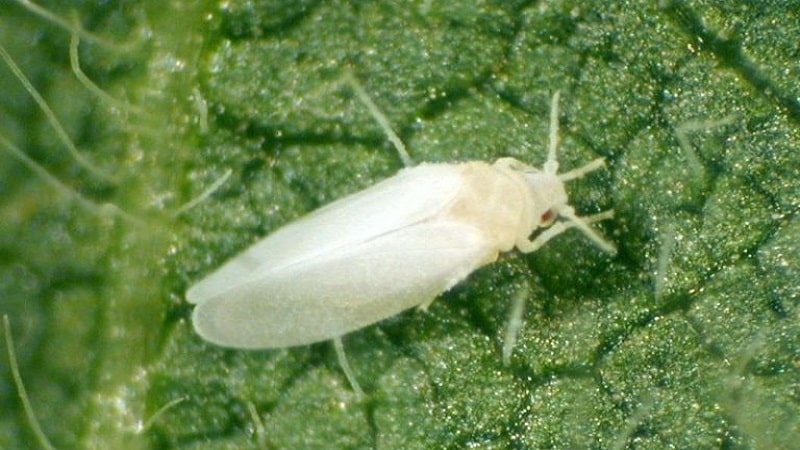
Signs of infection
It is easy to recognize plant damage by the following external signs:
- yellowing and curling of leaves;
- uneven ripening of fruits;
- discoloration of the internal tissues of tomatoes;
- formation of plaque on the upper leaves;
- presence of insects on the inside of the leaf;
- when you touch the plant, a cloud of midges rises.
What kind of pests could these be?
Many insects can parasitize nightshades. There are two types of midges living on tomatoes: some pests are black in color and are constantly on the move, not inhabiting the plant. Other midges are white and settle on the leaves of seedlings.
The most dangerous pest is the greenhouse whitefly. Her body size is 3 mm. The insect prefers to inhabit the inside of the lower leaves of seedlings, where it lays eggs.
Whiteflies carry viral diseases - leaf curl, chlorosis and jaundice. If measures are not taken in time, this may affect the growth, flowering of the plant, its leaves and fruits.
The moths themselves are not so dangerous - they can be easily eliminated using folk or chemical means. However, it is not so easy to deal with insect larvae - they have protection in the form of a special coating, which reduces the effectiveness of the drugs. In addition, if you use the same products, insects can develop immunity to them.
What harm can they do?
White midges are the most dangerous pests of nightshades. Despite their small size, the damage they cause can be colossal. As soon as midges or their larvae attach to the plant, they begin to consume its sap. Because of this seedling begins to experience a lack of nutrients, which affects its fruits. As a result, the green mass of the plant dries out and falls off, and the fruits wrinkle.
The vital activity of small midges leads to the formation of plaque on the top of the leaf, which can cause it to curl. At first it has a transparent color, which later turns black, indicating the formation of sooty fungi. Parasites appear from insect secretions. They cover the plant stem and fruits.
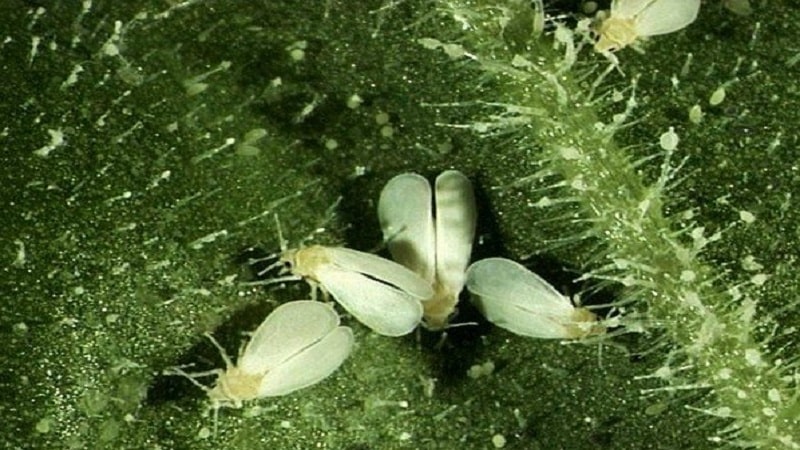
Types of insect control
It is important to note that not all control methods are effective at all stages of insect development. The plaque that forms on the leaves as a result of the vital activity of midges is a barrier against chemical and biological agents. Therefore, to quickly destroy pests, you need to use an integrated approach.
Chemical control methods
Manufacturers annually produce a large number of drugs against pests. Before purchasing the product, you need to study the instructions in order to properly process the plant. Some drugs only need to be sprayed once, others need to be used regularly.
It is important to choose a drug suitable for a certain stage of insect development. So, moth repellents will not help get rid of larvae and pupae. Spraying is ineffective in controlling adults; they can fly from plant to plant.
Types of chemicals against whiteflies:
- systemic insecticides - the drug penetrates the plant sap and poisons insects;
- contact insecticides - act upon direct contact of the pest with the treated plant.
Important! Systemic drugs should not be used during the harvest period. The last treatment should be no later than 25-30 days before harvesting the fruits.
The most effective drugs against white midges are:
- "Pegasus";
- "Fufanon";
- "Confidor Extra";
- "Aktara";
- "Mospilan";
- "Decis-pro";
- "Phosbecide";
- "Aktellik".
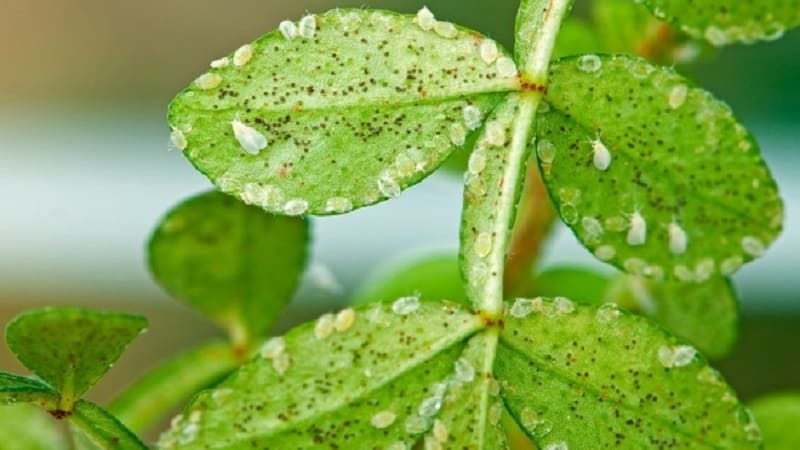
Processing rules
So:
- The procedure is carried out on a warm, windless day.
- Chemicals are applied using a spray bottle.
- After treatment, you need to bring the plants into the shade or place a canopy over them to avoid burns.
- Alternate medications regularly.
- Use a product suitable for the specific stage of insect development.
Important! Do not immediately use strong chemicals; toxic compounds can accumulate in the soil and poison the plants.
Biological drugs
The essence of biological agents is the use of living microorganisms that can resist the action of pests. In the case of whiteflies, manufacturers produce preparations with insects that can eat white midge larvae.
A cardboard with a biological product is hung on tomato bushes. After some time, microorganisms begin to spread throughout the plant, destroying whitefly larvae and pupae.
Fitoverm is considered the most effective biological preparation; after its use, you can harvest within two days. The product contains compounds that quickly decompose in the soil; they do not harm the plant.
Traditional proven methods
Experienced summer residents note that folk remedies can effectively combat pests without developing resistance in them.
These methods include:
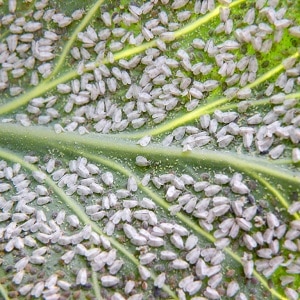 Cold. Moths do not like low temperatures, so you need to take the seedlings out into the fresh air from time to time. The method is suitable only for cold-resistant varieties; the pest will die only when the temperature drops to +10C.
Cold. Moths do not like low temperatures, so you need to take the seedlings out into the fresh air from time to time. The method is suitable only for cold-resistant varieties; the pest will die only when the temperature drops to +10C.- Insect traps. Glue baits, which can be made at home, are especially effective - a sheet of plywood is painted yellow and generously smeared with glue, Vaseline, oil or honey.The bait is placed near the affected plants. You can also hang regular adhesive fly tape.
- Infusion of yarrow. Pour 1 kg of plant leaves into a bucket of water and leave for two days in a warm place. Then the infusion is filtered. It is used for spraying. The procedure is carried out 2-3 times with an interval of 7 days.
- Dandelion decoction - Pour 1 kg of fresh flowers into 1 bucket of water, add 1 tbsp. washing powder. The mixture is infused for a day, then filtered. Suitable for processing bushes and soil.
- Soap products - used when there are large numbers of insects, as well as in cases where the use of chemicals is undesirable. To treat the leaves, you can use laundry soap - grind 1 bar and dilute it in water in a ratio of 1:6. Before applying to the leaves, you need to whip up the foam; you can also spray the bushes with the solution. The product does not require rinsing.
- Garlic infusion - chop 10 cloves and add 5 liters of water, leave to infuse overnight in a warm place. Before use, the infusion must be filtered.
- Water - used for wiping leaves. Effective in the fight against adult insects.
Fumigation of greenhouses
The procedure should be carried out twice a year - before planting seedlings and after harvesting. Before fumigation, you need to close the windows and doors, and also plug all the cracks.
Sulfur candles can be used for fumigation, but they are only suitable if the room is located away from residential buildings. Before carrying out the procedure, you need to remove all tomatoes from the greenhouse.
You can use smoke bombs with insecticides in those greenhouses that are located near your home. In this case, you can leave the seedlings in the greenhouse.The product will help kill not only adults, but also larvae, and will also protect against various diseases.
The smoke control method can be carried out using tobacco. You need to put a sheet of iron on the ground, on top of which you put newspaper, wood chips and tobacco. Before the procedure, you need to lubricate the glass of the greenhouse with Vaseline. After the fire is lit, the disturbed insects will rush to the windows and stick to them.
What herbs will save tomatoes?
By sowing the right herbs in an area with tomato beds, you can forget about pests forever. These herbs include dill - it attracts insects that feed on midges. It can be planted between the beds.
Experienced summer residents often plant tobacco along the perimeter of the site. Although this plant will not repel whiteflies, it will bear the brunt of the attack. Most of the insects will begin to settle in the tobacco bushes, which will give the vegetable grower time to begin pest control.
Mechanical methods
The fight against whiteflies in a greenhouse is also carried out using light and natural enemies of midges. You can also catch adults using a vacuum cleaner.
Whiteflies, like other moths, are attracted to light. One person enters the greenhouse and begins to shake the bushes, while the other stands at the exit and holds a blowtorch in his hands. This procedure can be carried out every 2-3 days.
During the day, you can spread pieces of foil between the beds. The sun's rays will reflect off the foil and fall on the lower leaves of the tomatoes where the insects live.
The enemies of white midges are ladybugs and lacewings. If you attract these insects to the area, you can quickly eliminate the problem. You can also populate the greenhouse with pupae of the encarsia wasp and the macrolophus bug.
The nuances of getting rid of midges
The conditions for growing tomatoes in open ground and in a greenhouse are significantly different. Midges can appear in both closed and open beds. When dealing with pests, it is important to take into account some features.
In the open ground
Whitefly can also attack seedlings grown in open ground. Often, to preserve the harvest, summer residents use folk remedies. These include herbs, soap, garlic or ash. Using ammonia is also effective - dilute 50 ml of the product in a bucket of water.
You can add a little liquid soap to the solution. The product is used for spraying, the procedure is carried out once every 3 days until the pest is completely destroyed.
How to get rid of midges on tomatoes in a greenhouse
To destroy whiteflies in a greenhouse, you can use not only insecticides, but also conventional fumigators and spirals. Before turning on the device, you need to close the windows and doors. It is better to leave the premises during this period. Sticky anti-fly tapes can be hung throughout the greenhouse.
It is known that midges do not like the cold, so at night you can open the windows for ventilation.
After treating plants with chemicals, you need to create shade. To do this, you can cover the roof of the greenhouse with a dark, thick fabric.
Compost should not be stored indoors as it attracts insects. It is best to store it in a box on the site, away from greenhouses and greenhouses.
To treat plants indoors, you can use bleach - dilute 0.5 kg of the substance in 12 liters of water, leave for 2-3 hours. The product is used for spraying on beds.
To combat midges, you can use a mixture of dry tobacco and ash. The components are mixed and used to treat the soil.
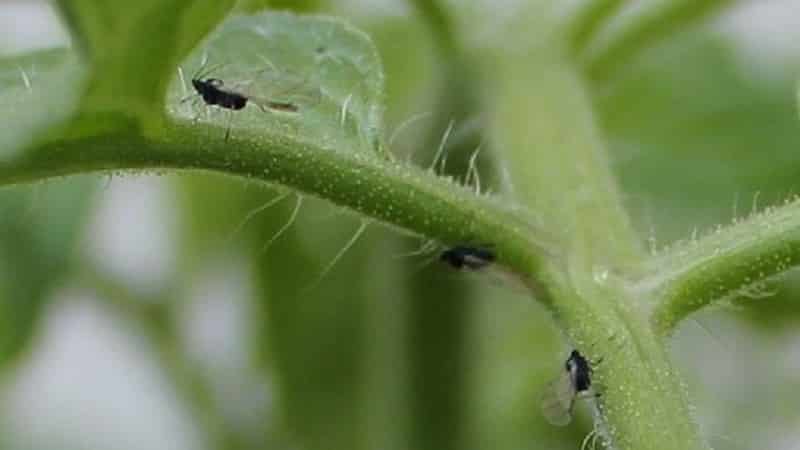
Seedling protection
You can protect seedlings from whiteflies by pre-planting the soil with insecticides. It is also important to keep a distance when planting plants, since insects love dense beds due to impaired air circulation and moisture evaporation.
Tomatoes cannot be planted in the same place year after year. Moth larvae may be in the soil, so you need to follow the planting pattern - tomatoes can be returned to their original bed only after 3-4 seasons.
Pest prevention
The white midge is an insect that is difficult to get rid of. You can fight it for a long time, which will negatively affect seedlings and harvests. The use of chemicals is not always appropriate, especially if the gardener wants to get an environmentally friendly product. It is better to prevent a problem from occurring than to try to fix it later.
Preventive measures:
- Ventilate the greenhouse regularly even in winter.
- Disinfect structures.
- Keep the area clean - remove plant debris and weeds in a timely manner.
- Constantly dig up the soil.
- Do not store compost in a greenhouse or greenhouse.
Conclusion
Insect larvae may be in the soil, so it is important to treat not only the bush, but also the soil next to it. To do this, you can use Bazudina granules with a validity period of 6 weeks - the product needs to be applied. “Grom-2” has a longer-lasting effect; it protects plants from pests for up to two months.
In order for the drug granules to be evenly distributed in the soil, they need to be mixed with coarse dry sand. The product is applied to a depth of 2 cm, and then sprinkled with a layer of soil. After using the preparations, you should not immediately water the plants.
Compliance with prevention and creating conditions for plant growth does not always provide protection against pests. You need to get rid of white midges, otherwise you can lose the entire harvest. It is better to use an integrated approach in the fight against insects - combine traditional methods with biological and chemical preparations.